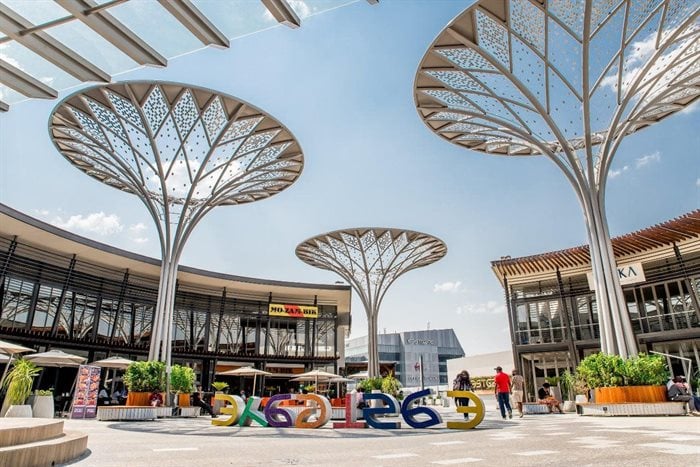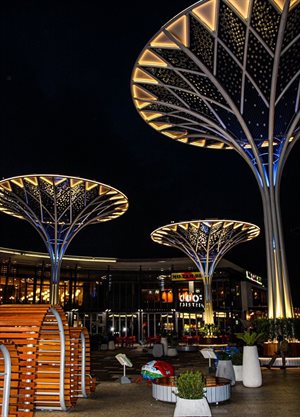
The solar trees are self-reliant, harnessing energy from the sun to illuminate at night. With a bespoke installation of lights, the trees also contribute to feature lighting in the piazza for approximately 5 to 6 hours, while operating off the grid.
Jonathan Sinden, chief operations officer at L2D comments: “The solar trees at Eastgate are an exciting initiative as we aim to implement renewable energy projects throughout our portfolio, while creating sustained value for our stakeholders. This initiative also aims to inspire customers to adopt sustainability practices in their everyday lives for the benefit of the natural environment.”
This initiative is in partnership with Architects Batley Partners, which took on the function of conceptualising a vision that would be befitting of the physical space, while matching the overall ethos of the centre with the ultimate goal of uplifting the atmosphere of the piazza for the benefit of its patrons.
The solar tree concept, inspired by a visit to Baine’ Baobabs in the Botswana Nxai Pan National Park, doubles as public art and further aims to bring new energy to the area, enabling photo opportunities and a sense of community and connectedness between visitors.
The aesthetics of the solar trees was dictated by the scale of the trees and their relationship to the shopping centre. Three is the smallest nuclear family unit in nature and with this, an ensemble comprising a large ‘father’ tree which towers at 13.5m in height and 14m in diameter, a slightly smaller ‘mother’ tree, and the smallest being a ‘child’ tree, was conceptualised. This concept speaks to Eastgate’s philosophy of creating family-focused activities, thus forming relatable, community-driven and memorable experiences.

The trees consist of tubular hollow steel sections that have a 20-year lifespan, requiring minor maintenance. The hollow steel sections mostly resemble tree ‘trunks’ and ‘branches’ and are extremely flexible, allowing for the necessary bendability, and convenient transporting and installation. The solar panels are set to operate for 10 years and are easily replaced. The solar trees are covered in a stainless-steel net called Jakob Webnet procured from Switzerland, and within this net, infills were placed to create an architectural effect. Several solar photovoltaic panels mounted on top of each spiral are able to provide light.
“It became remarkable how our design team had to continually adjust the trees’ components to resemble the geometry in nature and search for new types and ensembles of material to represent leaves and canopies in order to achieve a series of harmonious, sculptured architectural elements,” comments Edmund Batley from Batley Partners.
The design, manufacturing and installation of the solar trees saw over 200 people contributing to the successful completion of this project. The contractor responsible for bringing to life and constructing the solar trees was Anchor ENGinuity.
“Anchor ENGinuity is exceptionally proud of this project. Having had many years of experience in the specialised steel field, the Eastgate Solar Tree project is definitely one of the most iconic steel structures in South Africa. Integrating the steel component with electrical, solar and stainless-steel cladding really creates a very special and unique world-class structure,” says Andrew Kirkland from Anchor ENGinuity.